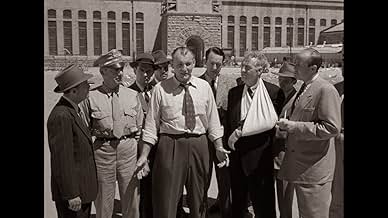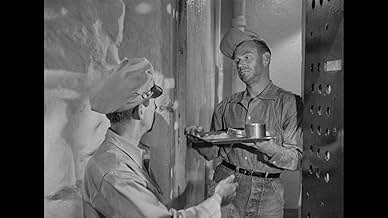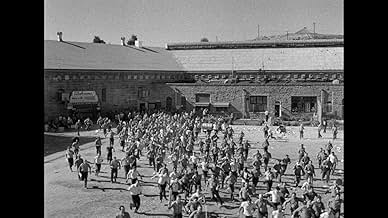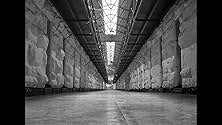Agrega una trama en tu idiomaFed up with the inhumane prison living conditions, a general prison riot breaks out, leading to hostage-taking, a stand-off with the guards and eventual negotiations with the prison administ... Leer todoFed up with the inhumane prison living conditions, a general prison riot breaks out, leading to hostage-taking, a stand-off with the guards and eventual negotiations with the prison administration officials.Fed up with the inhumane prison living conditions, a general prison riot breaks out, leading to hostage-taking, a stand-off with the guards and eventual negotiations with the prison administration officials.
- Nominada a2premios BAFTA
- 3 nominaciones en total
Opiniones destacadas
The prisoners make their demands known, and they want them printed in the papers for all the public to see. They want to be involved in a work program instead of sitting idle; they want the jail to be less crowded and better organized. If their needs are not met, guards will be killed, and the blame will be placed on the penal system authorities. The liberal warden of the prison actually wants to grant their demands, but his budget is constrained by politicians far removed from the system, and thus he is helpless as the clock ticks down.
The film is non-stop excitement and drama. I liked seeing the relationship between the prisoners, and their roles in the revolt. Neville Brand, with a gravelly voice and a build like a Sherman tank, is perfectly cast as the group leader and negotiator.
The movie is based on a story of an actual prison riot in the 1950s, and producer Walter Wanger's experiences as an inmate. Isn't it odd that celebrities get religion on the issue of prison reform AFTER they have been behind bars? Dan Rostenkowski comes to mind too.
The resulting 1954 80 minute gritty drama, almost an unprecedented certificate 15, even now, was directed by Don Siegel. Following a popular format in those days, it starts off with a social documentary approach, complete with concerned voice-over - that this is a public announcement, part expose, part drama. It is not based on fact, at least not from one singular incident.
As you might expect, we follow prison guards (my title is the warning given to them, as they arm-up to thwart the riot), politicians and those who shape policy and of course, a handful of inmates. These provide everyday backbone; their tales are simple and uncomplicated and it's impossible to not side with them, or at least their plight. As ring- leaders take guards hostage, it becomes a nail-biting cat and mouse scenario, with Dunn (Neville Brand) producing ultimatums. Warden Emile Meyer wants negotiation, state officials want only swift force.
The film is well made and tautly directed, efficient but doesn't feel rushed. The version I saw on TCM (Turner Classic Movies) had a slight green cast but was generally good. I imagine that Riot In would have been compelling and possibly controversial viewing for cinema goers. It would have found favour especially amongst those who liked the hard crime film-noir type of dramas of the day, but without any of the glamour of femme fetales.
My guess is that whilst many prison dramas had been made at this point, they were character-lead and not out to socially comment. This would have been as hard-hitting as any TV '60 Minute' (etc) documentary and because it's still a good and credible film, it's still within the public domain, though is rarely shown and expensive to buy.
Tho what is known as a "B" movie, and with a budget to match such a programmer, Riot In Cell Block 11 remains today one of the finest entries in the incarceration based genre of film. As relevant today as it was back then, the film has much grit and realism coursing thru its veins. Directed by Don Siegel (Dirty Harry/Escape From Alcatraz), it's written by Richard Collins (uncredited on Invasion Of The Body Snatchers), but it's with producer Walter Wanger that the core of the piece belongs. In 1951 Wanger was convicted of the attempted murder of Jennings Lang. Lang was having an affair with Wanger's wife, and when Wanger caught them in the act, he shot Lang in the groin. Wanger, after copping a plea of temporary insanity, served four months in San Quentin Prison, where his experiences there provided the genesis for Riot in Cell Block 11.
Shot in a semi-documentary style on location at California's Folsom Prison, Siegel and Wanger used actual inmates and guards to authenticate their movie. This was made possible by a certain Sam Peckinpah, who here was doing his first film work as a third assistant director. Legend has it that the Warden of Folsom knew "Bloody Sam's" family and thus allowed the makers into the prison to film. The film also benefits by not having big name stars filling out the cast, Brand & Meyer are joined by Frank Faylen, Leo Gordon, Robert Osterloh, Paul Frees & Whit Bissell. Solid performers to a man, but no headliners, and this helps, as they mix with the real crims and coppers, the realistic feel the makers created.
Siegel's movie isn't looking for simple answers to a persistent problem, it could have easily just gone for a death or glory violent piece of entertainment. But instead it's laced with intelligence and never sinks to preaching, in fact its finale is a rather sombre footnote to the whole episode. The characters are excellently drawn too, and it's good to see that Collins and co don't just make this a cons against authority piece, they clash with each other. Thus hitting home that not all the cons are singing off of the same page. As Warden Reynolds tells when asked about riot leader Dunn, "he's a psychopath, but he's an intelligent psychopath - just like many others on the outside" it's a telling piece of writing. As is the fact that there's no soft soaping either, there's no redemptive love interests or old sage lags to talk common sense into the ring leaders, it's tough uncompromising stuff.
And while we are noting the need for reform, feeling a bond with the prisoners complaints, we are then jolted to not forget that evil men do still reside here. Evil that is perfectly essayed by an excellent Leo Gordon (a real life San Quentin resident) as Crazy Mike Carnie. Watch out for one scene involving a call to a guards wife, the impact is like taking a blow from a claw hammer. You will understand why Siegel said Gordon was the scariest man he ever met.
A top draw movie that doesn't take sides, it has both sides of the fence firmly in its sights. With us the public observing from the middle. 10/10
The producer Walter Wanger (known for Ford's "Stagecoach" and Hitchcock's "Foreign Correspondent") had recently been in prison for shooting his wife's lover, and his experience there motivated this production. The film was shot on location at Folsom State Prison with real inmates and guards playing background roles.
"Riot in Cell Block 11" was the first film work for Sam Peckinpah, who was hired as a third assistant casting director by Don Siegel. Wanger and Siegel would team up again two years later for "Invasion of the Body Snatchers".
The Criterion release is a must-have, with plenty of background information on those involved, the inspiration, related writings and an excellent audio commentary from a noted film historian.
As far as prison pictures go - This gritty, low-budget, tough-guy tale (though mighty tame by today's standards) still packed a substantial wallop even without a non-stop barrage of profanity and bloodshed.
Filmed (in b&w) on location at Folsom State Prison, California - This particular picture is notable for being one of the first in its genre to have the disgruntled convicts manipulate the media in order to make their grievances about prison conditions known to the public.
Yes. This picture featured typical, prison stereotypes. And, yes, it contained its fair share of unintentional humour, as well - But, all the same - (With its fast-paced, 80-minute running time) - It was still well-worth a view.
"Riot In Cell Block 11" (which was produced on a $300,000 budget) was directed by Don Siegel, who would later go on to direct Clint Eastwood in 1971's Dirty Harry.
¿Sabías que…?
- TriviaLeo Gordon had served five years for armed robbery at San Quentin State Prison. For this reason, Heinze, the Folsom warden, originally objected to Gordon appearing in the film, but director Don Siegel was able to convince him that Gordon was no threat to the prison.
- ErroresWhen the state police force the convicts back into the prison by launching a barrage of tear gas at them, the police move forward, into the area being bombarded. The convicts are overcome by the gas, but the police aren't - even though they're not wearing gas masks and are enshrouded by the same gas the convicts are.
- Citas
Warden Reynolds: I promise you no harm will come to you during this conversation. Guard! These are my instructions. Dunn is to be allowed to come into this yard and return to 11 without interference.
- Créditos curiososThe following acknowledgment appears after the opening credits: "We wish to thank Mr. Richard A. McGee and his staff of the California Department of Corrections, Warden Heinze, Associate Warden Ryan, Correctional officers and the inmates of Folsom Prison for their co-operation."
- ConexionesEdited into Crashout (1955)
Selecciones populares
- How long is Riot in Cell Block 11?Con tecnología de Alexa
Detalles
- Fecha de lanzamiento
- País de origen
- Idioma
- También se conoce como
- Terror in Block 11
- Locaciones de filmación
- Productora
- Ver más créditos de la compañía en IMDbPro
Taquilla
- Presupuesto
- USD 298,780 (estimado)
- Tiempo de ejecución
- 1h 20min(80 min)
- Color
- Relación de aspecto
- 1.37 : 1


































